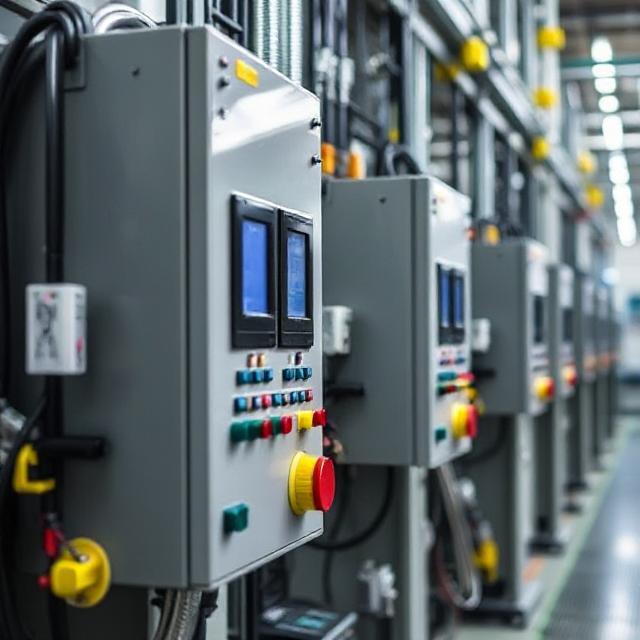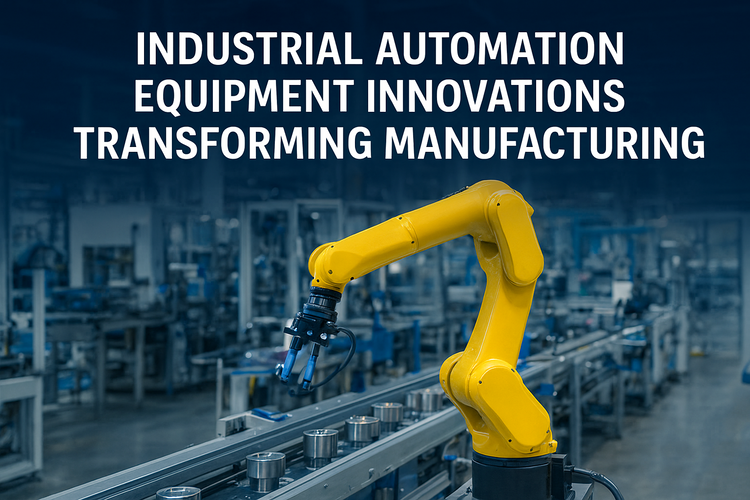Industrial automation has emerged as a transformative force in the modern manufacturing industry. By integrating advanced technologies, businesses can increase productivity, ensure precision, and reduce operational costs. In this blog, we will explore industrial automation, the essential equipment used, and the latest innovations transforming manufacturing globally.
What is Industrial Automation?
Industrial automation refers to the use of control systems, machinery, and technology to operate industrial processes with minimal human intervention. The main goal is to improve efficiency, accuracy, and safety in manufacturing operations. Automation can range from simple mechanical devices to complex computer-controlled systems.
Historically, automation started with the introduction of basic machines and evolved into highly intelligent systems that can monitor, control, and optimize production in real-time. Today, industrial automation is crucial across various sectors such as automotive, electronics, pharmaceuticals, food processing, and heavy machinery.
Benefits of Industrial Automation in Manufacturing

Implementing automation in manufacturing brings numerous advantages, including:
- Enhanced Productivity: Automated systems can operate 24/7 without fatigue, significantly increasing production rates.
- Improved Quality: Automation ensures consistent performance, reducing errors and defects.
- Safety: Dangerous tasks can be performed by machines, protecting workers from hazardous environments.
- Data Collection and Analytics: Advanced automated systems provide real-time insights into production efficiency and equipment performance.
Key Industrial Automation Equipment
Industrial automation involves various types of equipment, each playing a crucial role in modern manufacturing. Below, we discuss the most important categories and examples:
1. Programmable Logic Controllers (PLCs)
PLCs are digital computers used to control manufacturing processes. They are highly reliable and can handle multiple inputs and outputs in real-time.
Key Features:
- Control machinery in assembly lines.
- Monitor sensors and actuators.
- Flexible programming for different processes.
Applications:
- Conveyor systems in food packaging.
- Robotic assembly in automotive manufacturing.
- Temperature control in chemical processes.
2. Human-Machine Interfaces (HMIs)
HMIs act as the interface between operators and machines. They display real-time data, allow control commands, and provide alerts.
Key Features:
- Touchscreen displays with graphical interfaces.
- Real-time monitoring of production lines.
- Customizable dashboards for operators.
Applications:
- Monitoring robotic arms.
- Adjusting machine settings in textile production.
- Supervising automated material handling systems.
3. Industrial Robots
Industrial robots are programmable machines capable of performing tasks automatically. They are widely used in high-precision operations.
Types:
- Articulated Robots: Highly flexible, ideal for assembly.
- SCARA Robots: Perfect for high-speed pick-and-place operations.
- Delta Robots: Used for fast packaging and sorting.
Applications:
- Welding, painting, and assembly in automotive plants.
- Packaging and sorting in food and beverage industry.
- Handling hazardous materials in chemical plants.
4. Sensors and Actuators
Sensors and actuators are essential for feedback and control in automation systems. Sensors collect data from the environment, while actuators perform actions based on controller commands.
Common Sensors:
- Proximity sensors
- Temperature sensors
- Pressure sensors
- Flow sensors
Common Actuators:
- Pneumatic actuators
- Hydraulic actuators
- Electric motors
Applications:
- Detecting material presence on conveyor belts.
- Controlling robotic arm movement.
- Monitoring temperature and pressure in industrial ovens.
5. Industrial Drives and Motors
Drives and motors provide motion control for machines and automation systems. They are responsible for speed, torque, and position control.
Types:
- AC and DC motors
- Servo motors for precise control
- Variable Frequency Drives (VFDs) for speed adjustment
Applications:
- Conveyor belt systems
- CNC machines
- Automated assembly lines
6. Supervisory Control and Data Acquisition Systems
SCADA systems are software platforms used to monitor and control industrial processes remotely. They collect real-time data from sensors and devices, providing actionable insights.
Key Features:
- Centralized monitoring of multiple machines.
- Historical data logging and reporting.
- Alarm management for predictive maintenance.
Applications:
- Power plant operations.
- Water treatment plants.
- Manufacturing process optimization.
7. Industrial Communication Systems
Industrial communication systems enable data exchange between machines, controllers, and software. They are essential for coordinated and synchronized operations.
Common Protocols:
- Modbus
- Profibus
- Ethernet/IP
- CAN Bus
Applications:
- Coordinating robots in assembly lines.
- Integrating PLCs and SCADA systems.
- Real-time monitoring of production facilities.
8. Conveyor Systems and Material Handling Equipment
Material handling equipment ensures efficient movement of raw materials and products throughout the manufacturing plant. Conveyor belts, automated guided vehicles (AGVs), and robotic arms play a significant role.
Applications:
- Transporting goods in warehouses.
- Automating assembly line material flow.
- Sorting packages in logistics centers.
9. CNC Machines (Computer Numerical Control)
CNC machines are automated machine tools controlled by computer programs. They are widely used for precision manufacturing of metal and plastic components.
Applications:
- Milling, drilling, and turning of components.
- Production of automotive parts.
- Manufacturing electronic enclosures.
10. Industrial IoT (IIoT) Devices
IIoT devices collect and transmit real-time data from machines to cloud platforms. This allows manufacturers to monitor performance, predict failures, and optimize processes.
Applications:
- Predictive maintenance in factories.
- Remote monitoring of equipment.
- Energy management and efficiency analysis.
Innovations Transforming Industrial Automation

The industrial automation landscape is evolving rapidly. New innovations are making manufacturing smarter, safer, and more efficient.
1. Artificial Intelligence (AI) and Machine Learning
AI enables machines to learn from data and make intelligent decisions. In manufacturing, AI helps in predictive maintenance, quality inspection, and process optimization.
Examples:
- AI-powered vision systems detect defects in products.
- Predictive algorithms forecast equipment failures.
- Optimization of production schedules using AI models.
2. Collaborative Robots (Cobots)
Cobots are designed to work alongside humans safely. Unlike traditional industrial robots, they do not require safety cages.
Benefits:
- Flexible deployment in small factories.
- Reduced risk of accidents.
- Enhanced productivity in assembly and inspection tasks.
3. Digital Twin Technology
Digital twins are virtual replicas of physical systems. They simulate real-time operations, allowing manufacturers to test changes before implementation.
Benefits:
- Real-time monitoring and simulation.
- Early detection of potential issues.
- Optimization of production processes.
4. Advanced Robotics with AI Integration
Modern robots combine AI and automation to perform complex tasks such as sorting irregular objects, handling fragile items, or adaptive welding.
Applications:
- Automated electronics assembly.
- Pharmaceutical packaging.
- Complex material handling.
5. Energy-efficient Automation Systems
New automation technologies focus on reducing energy consumption while maintaining productivity. Smart drives, motors, and control systems play a key role.
Applications:
- Optimizing motor operations.
- Smart HVAC and lighting in factories.
- Energy monitoring dashboards.
Future of Industrial Automation
The future of industrial automation promises smarter factories with fully interconnected systems. Key trends include:
- Autonomous Factories: Self-operating facilities with minimal human intervention.
- Integration of AI and IIoT: Real-time data analytics to enhance efficiency.
- Sustainable Manufacturing: Reducing energy consumption and material waste.
- Advanced Human-Machine Collaboration: Safe and productive work environments with cobots.
As these innovations evolve, manufacturing will become faster, safer, and more adaptable, helping businesses meet global demands efficiently.
Industrial automation is no longer a luxury—it is a necessity for competitive manufacturing. By leveraging PLCs, robots, sensors, IIoT devices, and advanced AI-driven systems, businesses can improve productivity, reduce costs, and maintain high-quality standards.
Innovations in automation equipment, such as cobots, digital twins, predictive maintenance, and energy-efficient solutions, are transforming the way factories operate. Manufacturers that embrace these technologies will not only stay ahead of the competition but also shape the future of smart and sustainable manufacturing.

